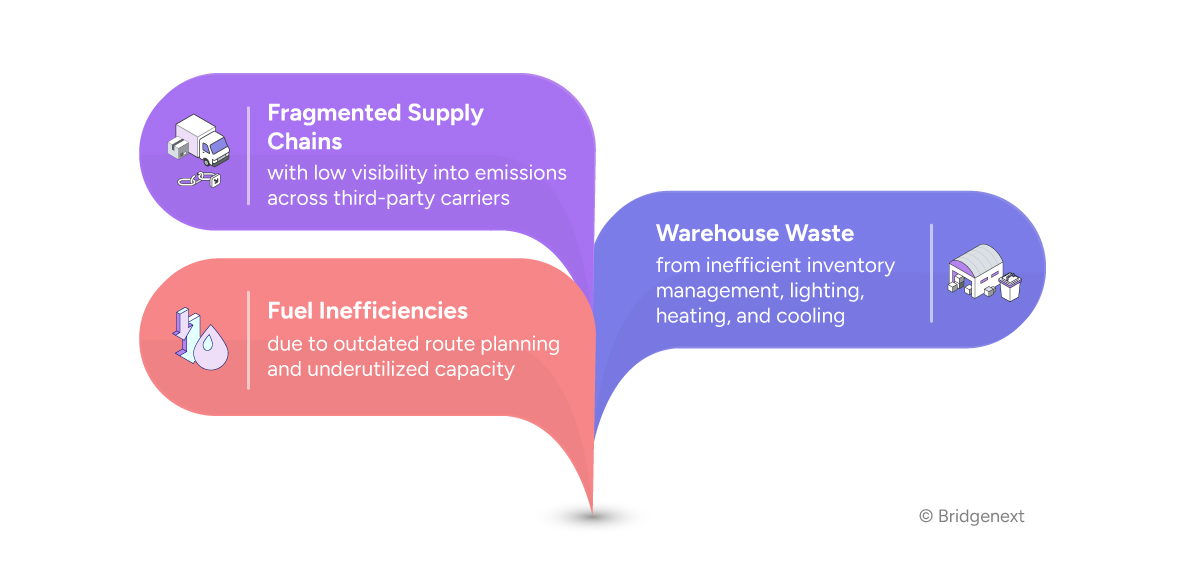06.24.25 By Foster Kaman

Everyone’s talking about sustainability and its impact on the world—but what does it really mean for logistics, and why does it matter? Is it just a checkbox to appear compliant and eco-conscious? Or is it something deeper?
With environmental concerns growing and regulations tightening, businesses—big and small—are under pressure to go green. But here’s the surprising part: sustainability isn’t just about electric trucks or expensive upgrades. It’s about something you already have—your data.
At the heart of smarter, greener logistics lies the ability to turn complex data into actionable insights. From optimizing transportation routes to reducing packaging waste, data is the real green engine driving change in supply chains. And with the right data engineering services, logistics companies can transform sustainability from a compliance checkbox into a competitive advantage.
In this blog, we dive into how logistics companies can unlock long-term sustainability—and real business value—by putting data at the center of their strategy.
According to the World Economic Forum, logistics operations contribute roughly 8 to 10 percent of global carbon emissions. The transportation and logistics value chain—across fleet operations, warehousing, packaging, and last-mile delivery—is resource-heavy by nature. But here’s the opportunity: the same areas that contribute to environmental impact are also where meaningful business value can be unlocked.
Let’s first understand what’s really holding back sustainability in logistics:

Now, imagine the flipside: what if these same inefficiencies became levers for value creation?
The bottom line? Sustainability can be a core strategy for growth, resilience, and competitive edge. But achieving it at scale requires a catalyst—and that catalyst is data.
Sustainable strategies often fail not because of lack of intent or effort, but due to lack of insight. Here’s where data becomes the hero.
Effective Data Governance in Transportation & Logistics operations requires a shift from reactive to proactive:
This type of clarity can transform sustainability from a feel-good initiative into a strategic lever. Let’s look at the tangible business impact that can be gained across some of the most common focus areas:
| Sustainable Focus Area | How Data Analytics Can Help | Business Value Realized |
|---|---|---|
| Route Optimization | Leverages real-time traffic, fuel consumption, and weather data to reduce miles and idle time | Lower emissions, improved delivery speed, reduced fuel costs |
| Vehicle Selection | Assesses performance data to identify optimal fuel-efficient or alternative fuel vehicles | Smarter CapEx planning, reduced total cost of ownership |
| Predictive Maintenance | Uses sensor data to flag issues before breakdowns occur | Fewer delays, optimized uptime, reduced emissions per trip |
| Fleet Management | Aligns vehicle usage with demand and evaluates EV readiness across fleet operations | Balanced resource utilization, higher ROI from assets |
| Demand Forecasting | Analyzes historical + external data to plan capacity accurately | Optimized capacity planning, optimized staffing, minimized excess trips |
| Load Balancing | Improves vehicle load ratio using data on weight and volume constraints | Fewer empty miles, better fuel economy per shipment |
| Container Capacity Mapping | Matches cargo with available space and routes to minimize empty container runs | Reduced costs, better asset rotation, lower carbon footprint |
Sustainability initiatives backed by strong data analysis have significant transformative potential in addressing environmental challenges and leading organizations toward a more sustainable future. Let’s dive into a few use cases for better understanding.
A leading logistics company aimed to reduce its carbon footprint and operating costs. The company used data analytics to analyze historical transportation data, including traffic patterns, weather conditions, and delivery timeframes. Utilizing these insights, they developed an intelligent routing system that reduced travel time and minimized fuel consumption and emissions.
The results were impressive. The company substantially reduced carbon emissions, showcasing its sustainability commitment while cutting fuel expenses. Moreover, this optimization strategy enabled more efficient deliveries, enhanced customer satisfaction, and strengthened the company’s competitive edge. Through data-driven route optimization, this logistics firm demonstrated that sustainability and profitability can go hand in hand.
A leading trucking company embraced predictive maintenance powered by data analytics to address one of the industry’s most pressing sustainability challenges: fuel consumption.
By collecting and analyzing data from sensors installed in their fleet, the company gained valuable insights into the condition of their vehicles. Predictive algorithms were used to anticipate maintenance needs, prevent breakdowns, and optimize engine performance.
The outcomes were remarkable. The company experienced a significant reduction in unscheduled maintenance events, thereby minimizing downtime and saving on repair costs. Notably, the enhanced engine performance led to a substantial decrease in fuel consumption, contributing to lower carbon emissions. This initiative improved the company’s environmental footprint and bolstered its reputation as an industry leader committed to sustainability.
These are just two examples of how data doesn’t just inform—it transforms.
As a leader in transportation and logistics operations, you already know how much data is being generated—across GPS logs, telematics, order management systems, warehouse sensors, and even driver apps. But the real challenge? The data is often fragmented, inconsistent, and hard to act on.
To tap into its full potential, consider a few practical steps:
Data can do the heavy lifting but only if you structure it for impact. That’s where a trusted partner can help make sense of the chaos.
At Bridgenext, we understand that sustainability isn’t a one-time initiative – it’s a long-term journey that evolves over time. We work with transportation and logistics leaders who aren’t just looking to take the first step, but the next hundred confidently, strategically, and with measurable results.
Our proven data analytics and engineering frameworks and deep domain knowledge have helped T&L organizations:
We bring the tools, talent, and industry understanding needed to turn complex data into actionable insights ensuring that your sustainability strategy is grounded in business impact, not just ambition.
Let’s build a logistics operation that’s not just greener, but smarter. Schedule a call with our team to get started.